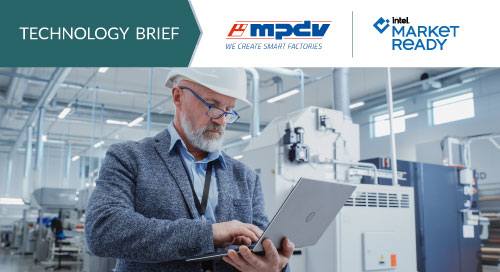Fill form to unlock content
Error - something went wrong!
Get the latest on IoT and network edge for manufacturing.
You are following this topic.
Integration Platform Orchestrates Factory Applications

Pick up your smartphone and notice the apps you have downloaded. Now if you look at another person’s device, you might notice an entirely different set. You chose the ones you did because you saw some use for them.
We take for granted that everyone can assemble the software on their smartphone as they wish. Just as we might have one app to check the weather and yet another to play today’s word game, manufacturers, too, might need a variety of applications to check inventory and another for quality control, and so on. Unfortunately, the software for these routine industry functions do not play well together.
If manufacturers want to use software from different vendors, they must take care of the integration themselves. “This is one of the biggest hurdles in smart manufacturing today,” says Matthias March, Director, Product Management, at MPDV Mikrolab GmbH, a supplier of Manufacturing Execution Systems (MES).
The smart factory needs many different solutions stitched together, but March points out that often each has its own data and its own data model. To develop a true smart factory, manufacturers need to integrate their solutions to gather the insights they need. “Specialty software addressing various needs in factories is plentiful, but companies struggle with the integration between incompatible systems,” he says.
The solution, says Bernd Berres, Principal in Product Management at MPDV, is to start with one integration platform on which to host the various software solutions, or manufacturing applications (mApps). “With such an integration platform it’s possible to bring in all solutions and they can communicate with each other [in a plug-and-play fashion] without designing multiple, separate interfaces,” Berres says.
To develop a true #SmartFactory, #manufacturers need to integrate their solutions to gather the insights they need. @MPDV_gmbh via @insightdottech
The Importance of MES for Manufacturing Applications
A well-functioning MES is the beating heart of the smart factory. It is the central system connecting all the operating elements on the shop floor. An MES connects operational data with business data from the Enterprise Resource Planning (ERP) software, Berres points out.
HYDRA X is MPDV’s take on the industry MES. It includes a wide range of functions that cover the management of orders, resources, materials, assemblies, quality, and human resources. In a nod to the industry’s need for systems that talk to one another, the company hosts the HYDRA X solution on its central Manufacturing Integration Platform (MIP). Doing so drives home the point that manufacturers need one unified foundation for their software environment. “You could say that it’s the backbone for all the IT systems that manufacturers have for their production,” March says.
Understanding that manufacturers might not need all the functionality that HYDRA X provides, MPDV has broken each into an mApp. Going a step further, the MIP hosts a whole host of third-party mApps as well. The one condition is that all apps must follow the MIP’s rules of integration.
Just as a smartphone has an operating system that sets rules for apps, the MIP does so for the manufacturing industry. This allows manufacturers to pick the specific best-of-breed solutions they need from a smorgasbord of options. “In the past, customers selected a system and were then tied to the vendor due to the investments made,” Berres says. “Thanks to the MIP, customers do not have to opt for one provider; they can combine solutions from different vendors as necessary.”
As is the case with our smartphones, each user has specific requirements and compiles their individual solution by adding required apps from the store.
An Ecosystem of Manufacturing Applications
Mixing and matching mApps also changes the way systems integrators work, Berres says. “They no longer look for a solution from one vendor that meets most of the requirements. Instead they can select the best solution for each individual case and these can be from different providers.”
For example, Systems Integrator MEGLA uses the MIP from MPDV to ensure interoperability for various software applications that it recommends to its clients. For a hypothetical plastics manufacturer, the SI can recommend a stand-alone mApp for inspection of samples, that still works in the MPDV ecosystem. The SI evaluates manufacturers on a case-by-case basis to understand their bottlenecks and what potential solutions might work for them.
Manufacturers also work directly with MPDV, picking a set of solutions that they need for specific operating environments. The German glassmaker Schott AG was looking for a universal platform for its 42 production sites around the world. The challenge was to integrate global IT and OT operations for analysis and insight while still providing custom solutions to each site. Schott now uses the MPDV integration platform and mApps from both MPDV and other partners. “In addition, they create their own as needed,” March says. “They use our business logic, and with this solution it’s very flexible to bring things together.”
No matter which applications customers choose, they are “mission-critical” for companies. “We deliver software and need a reliable system for it to run on, which is what Intel provides for us. Intel is all about high availability,” Berres says.
The Future of a Smart Factory
March expects the future of manufacturing to be driven heavily by artificial intelligence (AI) because it facilitates a “self-regulating” factory, where problems fix themselves, if they have been seen before.
MPDV is working on delivering standardized AI solutions to the marketplace so that smaller and midsize companies can also avail themselves of AI’s abilities. Companies increasingly will look for bespoke solutions for their challenges. And being able to mix and match solutions that all speak a common language will continue to be the backbone of a profitable smart factory.
Edited by Georganne Benesch, Associate Editorial Director for insight.tech.